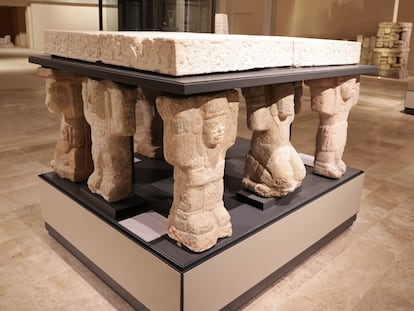Ichkabal, the ancient Mayan city set to rival Chichen Itzá as Mexico’s most-visited archaeological site
Known as the ‘Mesoamerican Egypt’ for the grandeur of its structures, Ichkabal contains three pyramids larger than Chichen Itzá’s Temple of Kukulcán and is scheduled to open to the public in September

Chichen Itzá, Mexico’s most popular archaeological site, which in 2023 recorded an influx of 2.3 million visitors, has fresh competition: Ichkabal, known as the “Mesoamerican Egypt” for the grandeur of its structures, contains three pyramids larger than Chichen Itzá's Temple of Kukulcán. With an area of 30 square kilometers and buildings that exceed 40 meters in height, it is one of the largest archaeological zones still standing and one of the oldest vestiges of Mayan culture. Ichkabal will open to the general public in September and aims to become one of the most-visited archaeological sites in the country.
A giant in Mayan history
The archaeological zone is 58 kilometers southwest of the Magical Town of Bacalar, one of the most popular tourist destinations in the region. Ichkabal, whose name means “among the lowlands” in Mayan, remained hidden under the dense jungle vegetation until it was discovered in 1995. Spanish archaeologist Enrique Nalda was one of the main researchers in the area until his death in 2010. Today, other experts who followed in his footsteps have worked intensively on its restoration, unearthing monumental structures that rival in size and complexity those of Chichén Itzá and Uxmal, two of the region’s most emblematic sites.
The type and layout of its buildings suggest that it was occupied from the late Preclassic period (400 B.C. to 200 A.D.) and was inhabited until about 1500 A.D., although most of the monumental architecture dates between 350 B.C. and 50 B.C. Its study has revealed that this city played a crucial role in the early development of the Mayan civilization. Ichkabal stands out for its imposing buildings and for a main plaza that stretches for 300 meters. The site, which in its heyday was an important political and cultural center, houses temples, pyramids, and advanced hydraulic systems, such as a recently discovered cistern used to store water and corn.
The structures in the area are large and attractive, but they have lost their façades. According to Diego Prieto, director of the National Institute of Anthropology and History (INAH), these “were not taken by contemporaries, they was taken by the same people who inhabited the city; this will undoubtedly be the defining characteristic of the city.”
Alan Maciel Vallejo, a researcher at the INAH, estimates that Ichkabal will attract a large number of visitors from its first year of opening, particularly due to its connection to the Maya Train and its proximity to Mahahual, a popular cruise ship port. “When ships arrive in Mahahual, they generally take tourists to two archaeological zones: Chacchoben and Kohunlich. So, Ichkabal, which is closer than Kohunlich, could have a larger capacity because of its proximity to Mahahual,” he explained.
The Maya Train and the revitalization of cultural heritage
The opening of Ichkabal is tentatively scheduled for September 14, within the framework of Mexico’s national holidays and in parallel to other openings in the region, such as the Hotel Tren Maya Palenque in Chiapas, the Jaguar Park in Tulum and the Quintana Roo Park in Chetumal. The new site seeks to become a pillar of archaeological tourism and a window into the beginnings of the ancient Mayan civilization.
The opening of Ichkabal is linked to the Maya Train project, which will connect the archaeological zone with other important sites in the region such as Kinichna, Kohunlich and Dzibanché. The rescue and restoration of 27 Mayan archaeological sites is being carried out by the Archaeological Zones Improvement Program (Promeza), a Mexican government initiative implemented by the federal Ministry of Culture, through the INAH and in collaboration with the National Tourism Development Fund, the Ministry of National Defense, and the consortiums participating in the construction of the Maya Train.
Sign up for our weekly newsletter to get more English-language news coverage from EL PAÍS USA Edition
Tu suscripción se está usando en otro dispositivo
¿Quieres añadir otro usuario a tu suscripción?
Si continúas leyendo en este dispositivo, no se podrá leer en el otro.
FlechaTu suscripción se está usando en otro dispositivo y solo puedes acceder a EL PAÍS desde un dispositivo a la vez.
Si quieres compartir tu cuenta, cambia tu suscripción a la modalidad Premium, así podrás añadir otro usuario. Cada uno accederá con su propia cuenta de email, lo que os permitirá personalizar vuestra experiencia en EL PAÍS.
¿Tienes una suscripción de empresa? Accede aquí para contratar más cuentas.
En el caso de no saber quién está usando tu cuenta, te recomendamos cambiar tu contraseña aquí.
Si decides continuar compartiendo tu cuenta, este mensaje se mostrará en tu dispositivo y en el de la otra persona que está usando tu cuenta de forma indefinida, afectando a tu experiencia de lectura. Puedes consultar aquí los términos y condiciones de la suscripción digital.
More information
Archived In
Últimas noticias
Most viewed
- Reinhard Genzel, Nobel laureate in physics: ‘One-minute videos will never give you the truth’
- Oona Chaplin: ‘I told James Cameron that I was living in a treehouse and starting a permaculture project with a friend’
- Pablo Escobar’s hippos: A serious environmental problem, 40 years on
- Chevy Chase, the beloved comedian who was a monster off camera: ‘Not everyone hated him, just the people who’ve worked with him’
- Why we lost the habit of sleeping in two segments and how that changed our sense of time









































